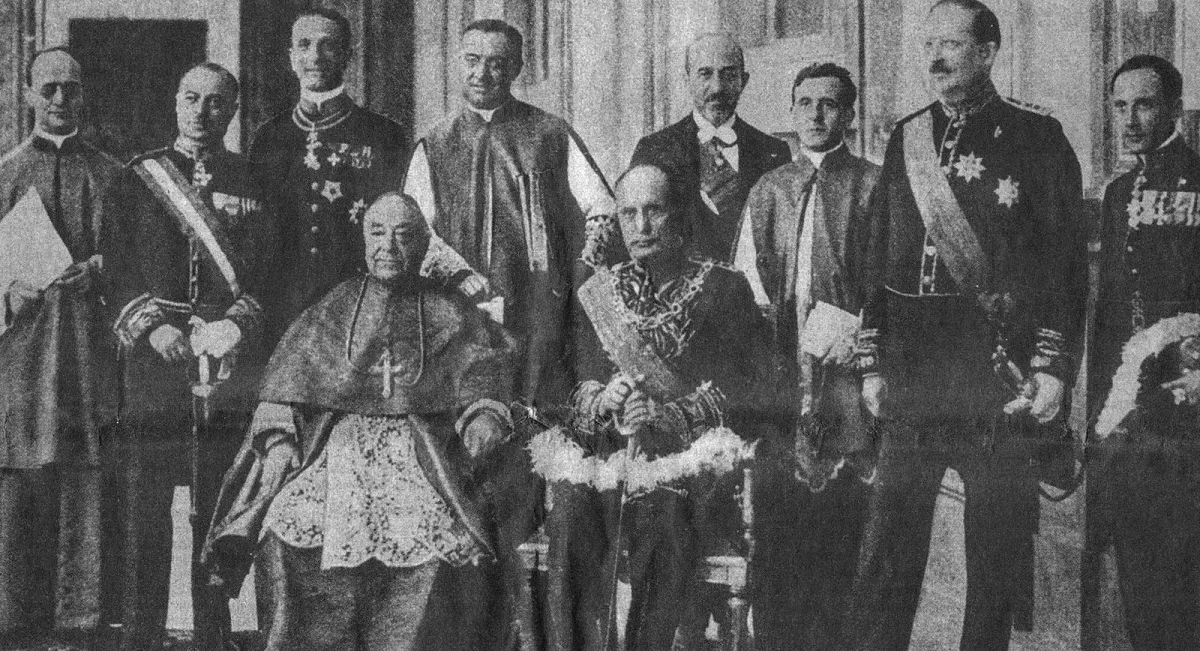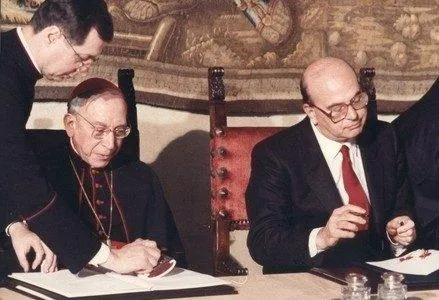
A public school’s decision to give its students (many of whom are Muslims) a day off for Eid al Fitr has generated unnecessary controversies.
By Alessandro Amicarelli — On March 17, 1861, with the proclamation made in Turin of the newly established Kingdom of Italy, the result of the annexation of the Kingdom of the Two Sicilies to the Kingdom of Sardinia, the first phase of united Italy began. It was a new sovereign state with the House of Savoy at its head and the Roman Catholic religion as the state religion.
In 1866, the Lombardo-Venetian Kingdom was taken from Austria-Hungary. In 1870, the Kingdom of Italy invading Rome annexed the Papal States, creating a conflict with the Roman Catholic Church. It lasted until 1929, when Mussolini entered into a Concordat with the Vatican.
In 1915, Italy entered the First World War. The victory meant taking from the Austro-Hungarian Empire, claiming they were Italian, the province of Trento, South Tyrol (called in Italian Alto Adige), and the littoral corresponding to today’s eastern Friuli and Trieste, as well as Istria and Dalmatia (later lost to Yugoslavia after Italy’s defeat in World War II).
The Giolitti government’s reforms, including universal male suffrage in 1915, greatly undermined the status quo and laid the groundwork for Mussolini’s ascent to power through the March on Rome in 1922 and the Fascist victory in the elections of 1924. At the end of World War I, Italy became territorially imposing and presented itself to the world as a great power, which would soon be conquered by Mussolini.
A socialist first and the founder of fascism later, Mussolini in contrast to anti-clerical socialist policies he had supported as a young politician, came to see in the clergy and the Church an instrument to increase his popularity in the Kingdom of Italy. In turn the Catholic Church, now deprived of the temporal power of the Papal States and greatly impoverished, saw in Mussolini a kind of “instrumentum regni” to reassert itself in the country.
Although strongly Catholic as a nation, the wound between state and church, created by the September 20, 1870, Italian invasion of Rome, was only healed in 1929 when Mussolini with the Lateran Pacts entered into the Concordat regulating Italy’s relations with the Vatican. The Lateran Pacts started a new period of unchallenged supremacy of the Catholic Church in the Kingdom of Italy.
The Lateran Pacts were signed by Benito Mussolini for the Italian side and Cardinal Pietro Gasparri for the nascent Vatican City-State on February 11, 1929. Mussolini was called by the Church “the Man sent by the Providence” and a providential omen was seen in his signing the Pacts on the day of the Feast of Our Lady of Lourdes, February 11.

Commemorative picture of the signature of the Lateran Pacts, February 11, 1929. Credits.
Article 1 of the Concordat stipulated that “Italy recognizes and reaffirms the principle consecrated in Article 1 of the Statute of the Kingdom of March 4, 1848, whereby the Catholic, Apostolic and Roman Religion is the sole religion of the State.”
With the fall of fascism, there was a new phase in which the Monarchy was dismissed through a referendum, giving birth to the Italian Republic in 1946. The Republican Constitution went into effect in 1948.
The break with the monarchical institutions that had guided the nation’s affirmation and expansion for eighty-five years, however, did not entail for the new republican Italy a break with the Catholic Church, which instead matured a position of prevalence and privilege in the country. In fact, the Republic did not renounce the nation’s primarily Roman Catholic identity and did not want to undermine Italy’s relations with the Holy See, a sovereign state recognized as such by Mussolini. Article 7 of the new Constitution, which is still in force today, states as follows: “The State and the Catholic Church are, each in its own order, independent and sovereign. Their relations are regulated by the Lateran Pacts. Amendments to the Pacts, accepted by both parties, do not require constitutional revision proceedings.”
Article 1 of the 1848 Statute also remained fully in force with the advent of the Republic. The Republic intended to leave unchanged the relations between Republican Italy and the Catholic Church exactly as Mussolini had shaped them in 1929, never questioning the role of the Church in the country nor the legitimacy of the existence of the Holy See as a sovereign and autonomous state.
It was not until February 18, 1984, that republican Italy, putting aside the Risorgimento and the monarchy—whose last King, Umberto II, had died in exile in the previous year, on March 19, 1983—, noting that the world was changing and that Italy had to adapt to the changes taking place in Western societies, implemented the decision to become a secular state, at least on paper.

Prime Minister Bettino Craxi for the Italian side and Cardinal Agostino Casaroli for the Vatican side signed the new agreement, amending the Concordat signed in 1929 within the Lateran Pacts, in Rome at Villa Madama on February 18, 1984, beginning a new course for the nation (the photo shows the moment of the signing, credits).
However, despite great expectations on the part of those more secularly inclined, and criticism from conservative Catholic circles, after forty years since that date, little has changed in terms of the position of the Catholic Church. Although it has lost the influence it had in the past, the Church has maintained a dominant position among the religions present in the country. What remains most noticeable in Italy is the different treatment of other religious denominations and their members.
In this regard, it is of interest to recall that King Charles Albert of Savoy, even before the Unification of Italy, had granted Letters Patent to the Waldensians (the oldest Protestant denomination in Italy) and the Jews in 1848. Article 8 of the Italian Constitution enshrines the equality of all religious denominations, with respect to which the expression “non-Catholic” is often used, while reaffirming the special historical role of the Roman Catholic Church in the country. Other religions, however, should have the same rights and duties as long as they are organized peacefully.
However, in actual practice, religious minorities in Italy have been treated very differently both in everyday life and in their relations with the state institutions. The latter have often contrasted the very possibility for these organizations to exist, seeing in them unwelcome competitors to the main confession that in fact many in the country still consider the official religion. As late as 2016, a history and geography textbook in use at high schools still proclaimed that “The official religion of our Republic is Catholicism” (L. Pepe, V. Novembri, E. Galimberti, Mirabilia. Percorsi integrati di storia e geografia, first edition, volume 1, Milan: Le Monnier Scuola, 2016, p. 249).
The fact that Roman Catholicism was until recently considered the official religion of the state and treated as such was confirmed by Article 402 of the Penal Code, which was titled “Vilification of the State Religion” and provided for up to a year’s imprisonment for anyone who offended the Catholic Church. It was not until the year 2000, 52 years after the Constitution’s entry into force, that the Constitutional Court ruled in Judgment No. 508/2000 that the provision was constitutionally unlawful.
Over the past forty years, many questions have been raised time and again in Italy regarding the principle of secularism of the state, from the call to remove crucifixes from public places such as courts and schools to the demand to avoid installing nativity scenes and singing Christmas carols or holding recitals in public schools—and much more.
The position of those who support secularism is that all sorts of religious symbols and representations should be avoided within public institutions along the lines of what happens in secularist France.
The position, on the other hand, of those who want to maintain religious (meaning Catholic) symbols and representations, emphasizes the right of Italians to honor their religious traditions. It also argues that in any case the families of pupils, as far as schools are concerned, have the right to self-determine the schools’ organization and its relationship with religious traditions.
We have heard these arguments for decades and they never came to a conclusion, at least until in 2011 the European Court of Human Rights in Strasbourg ruled on the case of “Lautsi v. Italy” and came out in favor of the right to keep crucifixes in Italian classrooms regarding them as cultural and not purely religious symbols.
It seems that the saying “tertium non datur” is particularly relevant in Italy, for it does not seem to be possible to find a third way as it exists in other nations, such as the United Kingdom for example, which despite having a state religion, ensures full freedom of religion and diversity within schools, including public schools.
Take the controversy that followed in the last few days the decision of a school, the Comprehensive Institute “Iqbal Masih” in Pioltello (Milan) to allow Muslim students to celebrate the end of the month of Ramadan (Eid al Fitr) at home by keeping the school closed on April 10, 2024.
The decision made by the school board with the agreement of the parents followed the realization that in previous years on the day of Eid al Fitr Muslim students did not attend classes. Since they are very numerous in the school, its principal decided that closing for that day was the most correct choice.
Schools have three days in each year to use as they deem fit in addition to the institutional holidays on which schools are closed according to a national calendar, such as for the Christmas and New Year holidays between December and January and for the Catholic Easter in March or April, as well as for secular holidays such as April 25 (Liberation Day, celebrating the end of Fascism) and May 1 (Workers’ Day).
I consider the choice made by the Iqbal Masih institute as one of maturity and conscience that in no way conflicts with current legislation. On the contrary, it respects it, does not undermine the principles of secularism of the state, and indeed honors the difference that should be normal and desirable in a democratic and secular country that advocates substantive equality.
Just as a school in which the majority of Catholic students can influence the activities of the institute through, for example, the installation of a nativity scene at Christmas time, it is not at all scandalous for a school to decide that it is appropriate to close for the private Eid al Fitr celebrations of Muslim students.
It should be noted that the school is not celebrating the Islamic holiday, but is merely being closed for one day to correspond with the date on which the end of Ramadan falls. Other schools, indeed most of them, celebrate Catholic holidays in some way in the schools’ premises.
The difference is not insignificant if one wants to emphasize the alleged risks for the secularity of the state in allowing a day without classes to accommodate Muslim students.
The controversy that followed this decision, leading to an intervention against the school by the national and regional school authorities (which were, however, criticized by the Catholic diocese of Milan, that praised the choice of the school as “adequate to the social reality of Pioltello”), was meaningless. The school’s decision did not contravene the principle of secularism of the state. The individuals and political parties that have raised the criticism against the school have never championed secularism when it came to installing nativity scenes in schools, or keeping schools closed for two weeks at Christmas time or on other Catholic holidays. Indeed, the same forces that in these days denounce that the school’s decision may endanger the secularity of the state, in the past assiduously insisted that it was appropriate to keep crucifixes and nativity scenes in schools and other public places to reaffirm the nation’s Catholic identity.
It is obvious that the controversy is an end in itself, influenced perhaps by a fear of diversity or by a mere anti-Islamic sentiment—if not by the need for some political parties to gather an easy support and votes in view of the almost imminent European elections next June.
Italy, because of its history and diversity, deserves a greater respect—just as minority religious communities deserve a greater respect. The principle of the secularity of the state must be implemented in a mature manner—certainly not by following the secularist system that punishes and discriminates against all forms of religion as if they were enemies of the state, nor by following the theocratic system of imposing one religious model against all others.
163 years after the birth of Italy and 78 years after the establishment of the Republic, the choice of the Iqbal Masih school to give pupils a day off to celebrate the end of Ramadan with their families, in compliance with current regulations, is to be applauded, whether in the end the school will be able to maintain it or not.
Let me conclude by asking a question: is it better to have a country with a rigid system of secularism that stifles all religious expressions, or one that while respecting its own traditions, cultural and religious, also respects minorities and celebrates diversity?
I personally hope that this may be the beginning of a new phase for Italy, in which diversity is accepted and not stifled in the name of fear and prejudice, or the supremacy of some over others.
Article also published on Bitter Winter





